| Northern Celestial Hemisphere |
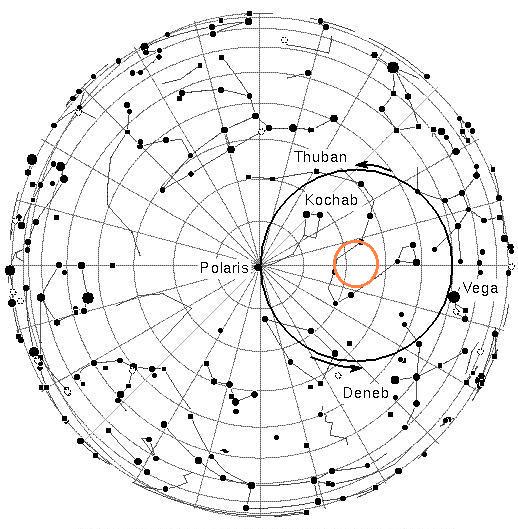
|
The black circle represents the path proposed for axis precession in the 26,000 year plan. Notice how Thuban is near the circumference. General precession theory suggests the axis of the Earth has rolled in a great circle in a counter clockwise direction so it now points to a location near Polaris. The axis of the roll is within the red circle.
If it were actually the Earth's axis that were moving around the black circle, then star catalog positional data over time should show the movement. What one would expect to see is all the stars moving in the same direction along the circle during the time period that observations are available.
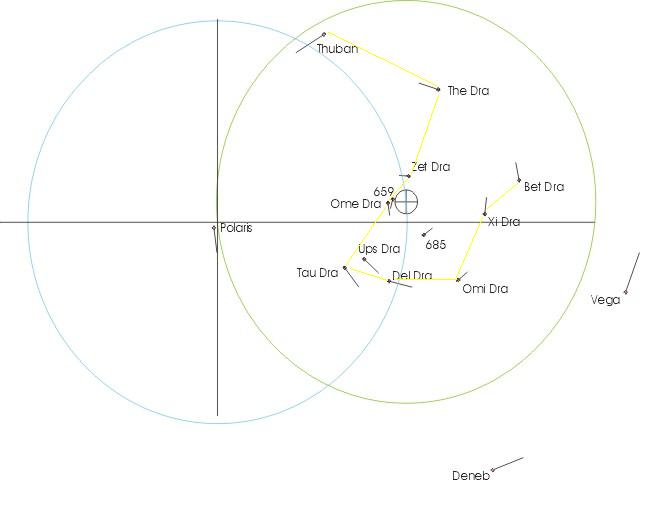
By using location data from the U. S. Naval Observatory's "Multiyear Interactive Computer Almanac" (MICA) 1990-2005, one can precisely layout the location and motion direction of circumpolar stars relative to Earth's North Pole. The above chart is derived from data for declination and right ascension from the FK5 catalog of stars contained in the MICA catalog. The direction of motion that is shown is the offset for the 10 year period from January, 1990 thru December, 1999.
As can be easily seen, the movement does NOT reflect a roll or wobble of the Earth's axis; that is, all stars moving in the same direction as the roll, but instead it reflects a spinning motion, or rotation around the small cross circle near Star 659 and Omega Draconis, which is also the axis of the Ecliptic. This spinning rotation is similar to what is observed on a daily basis as the Earth's diurnal rotatation about the North Celestial Pole near Polaris. One can only assume that the Earth's rotational axis is not rotating or spinning around both the ecliptic and the celestial poles at the same time. It is absurd to assert that the Earth's axis rotates about two points simultaenously.
A larger body, however, of which the Earth is a part, could be rotating about the small cross circle of the axis of the Ecliptic. We might assume the larger body of which the Earth is a part of, which is rotating about the second axis of the Ecliptic, is the entire Solar System and the axis of the Ecliptic is the center of Mass for the Solar System. That we can see it, is indicative that the Earth's axis is NOT moving in the wobble that general precession theory asserts, but remains relatively stationary as one would expect of gyroscopic stability, but rather the orientation of Earth's axis is moving because of the rotation of the Solar System.
Presumably the rotation of the Solar System could be residual from the creation and condensation of a rotating cloud of primordial substance. This is possible, and would better describe the observations of general precession effects than the currently theorized wobble.
We already know that the Sun orbits the Center of Mass and is not the Center of Mass. There could be a Saturn size body orbiting the Sun at the distance of 1.315 times 10E11 km in a nearly circular orbit. The period of this orbit works out to approximately 26K years and makes the velocity of the body about 1000 km/sec. This body, if it exists, establishes a center of mass for the Solar System approx 4.4 times 10E7 km from the sun. The Sun then, would orbit around the center of mass (as do all the rest of the planets), opposite the Saturn size body. The Sun would drag the orbits of the Earth and other inner system bodies around with its orbit. We would observe the rotation and see the stars move slowly, like a Procession of Equinoxes, because of the Earth's stable axis and stationary tilt. The stars would appear to rotate around a point at the Center of Mass, because the earth's tilt is stable, which is what we would expect from gyroscope motion observations.
The North Pole would appear to move just as the general theory of precession predicts; that is, it would appear to have moved from pointing at Thuban in the past, to pointing currently at Polaris and onward around the 47 degree diameter circle.
The likely location of the Saturn sized object that causes the Solar System to rotate? Approximately at a Declination of -23.5 degrees and Right Ascension 17 hr 36 min 53sec at Jan 1, 2000. The distance and velocity are as stated above. Will astronomers find it? Will they look?
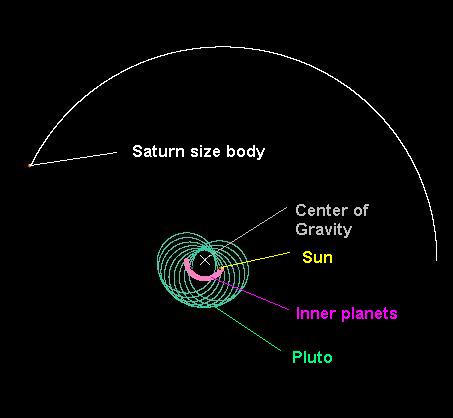
|
| Diagram created with OrbitXplorer 2.0 |
The Deep Sky Survey images below are of two exactly the same areas of the sky. The images on the right are lower resolution images from DSS I that were photographed in the 1950s. The Deep Sky Survey images on the left are from DSS II and were imaged at a higher resolution in the 1980s and 1990s.
These images are available here:
The RA and Dec need to be entered, select 6 by 6 arc minutes for the field size and gif as format.
The lower resolution images need to be color inverted, which can easily be done in windows paint program, where comparison of the images then becomes easy.
| Actual Deep Sky Survey Images |
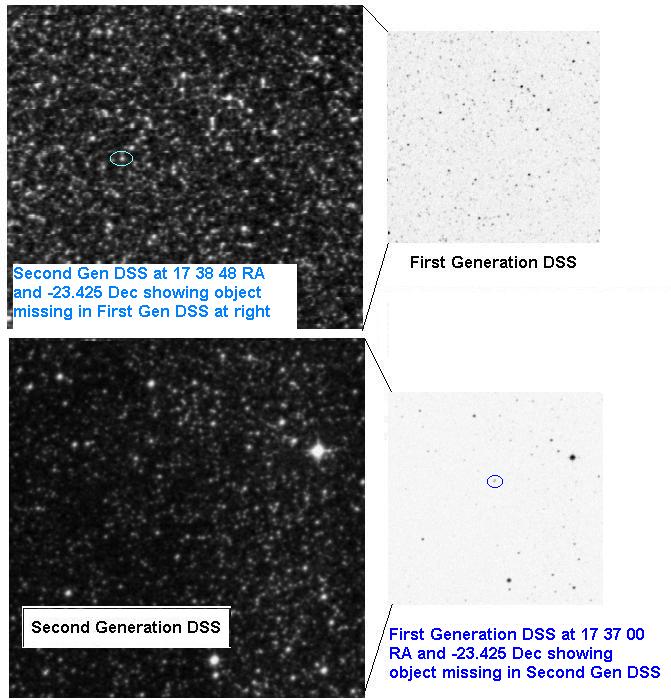
|
| Planet X? |
Former Heaven, Later Heaven and the Chinese Ladles
The history of Feng Shui reveals to us, there were two heavenly configurations; Former Heaven and Later Heaven. This memory is commemorated in two Ba Gua sequences of trigrams, Xian Tian Ba Gua or Former Heaven and the Hou Tian Ba Gua, or Later Heaven.
Both Ba Gua trigrams must have been developed during the time of Later Heaven, since during the time of Former Heaven, the concept of Later Heaven would not have been known. The Chinese schools that considered such changes retained sky charts from Former Heaven, in the form of Shi Pan compasses. During Later Heaven these schools fashioned Shi Pan compasses that reflected the current configuration of the Heaven that we are now in, apparently using a model available from the previous age. Below are images of Shi Pan Compasses of Former Heaven on the left and Later Heaven on the right. The Shi Pan on the left does not contain a Ba Gua trigram, while the one on the right does. Thus we distinguish the Shi Pan on the left to be the model of Former Heaven.
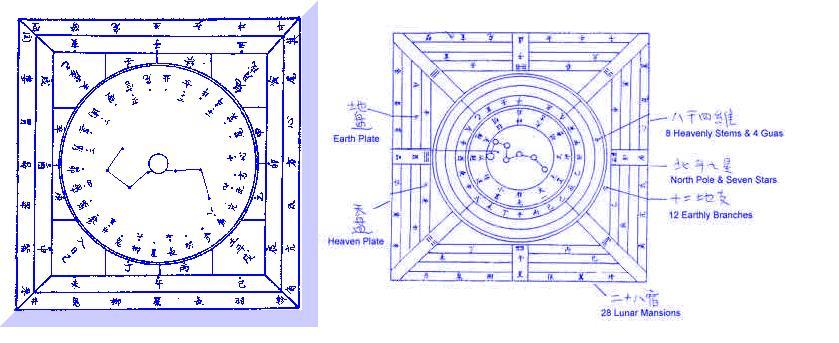
Both Shipans consist of a square fixed plate, which represents the earth, and a rotating round plate, which represents heaven. In the round plate there is drawn a constellation of stars, with a fixed pin around which heaven rotates. This we can relate with the diurnal rotation that is observed around the present North Star, Polaris. Both of the constellations pictured are assumed by some scholars to be akin to those of Western Astrology. This is a cultural bias that overwrites the Big Dipper in Ursa Major as the Chinese Northern Ladle of Former Heaven and the Little Dipper, or Ursa Minor as the Northern Ladle of Later Heaven. Neither of the Western Constellations looks anything like the constellations pictured above, however, nor do they rotate around the rotational points indicated.
Fortunately, we have detailed star charts that we can look at to see if there are constellations apparent that coincide with the Shipan constellations, and so by looking, we can see that they are actually there.
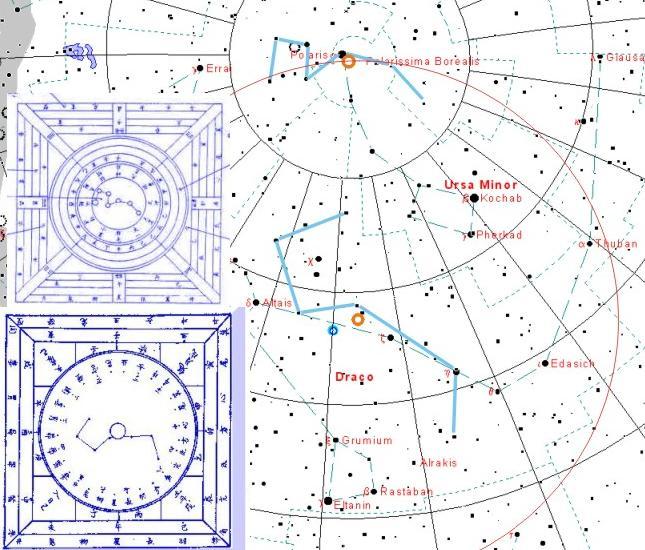
The small red circles on the star chart approximate the axis points of the Ecliptic spin of the Solar System and the Northern Pole axis. See how nicely they coincide with the spin centers of the constellation images on the Shipans.
Since the diurnal spin axis of the Early Heaven Shipan is clearly on the other side of the ladle handle from the spin axis of the Solar System Ecliptic, one might conclude that in an earlier time, the North Pole axis of the Earth pointed very close to the spin axis of the ecliptic. Then there was a cosmic event, an impact of the Comet, Seven Macaws that caused the Earth as a Gyroscope to precess its axis to point near the location of the star Alpha Draconis (Thuban). Thuban, as others have noted and documented is the first Pole Star to be observed by early Bronze Age civilizations in the time of Later Heaven. In the last 5000 years or so, the Pole Star has moved, due to the rotation of the Solar System, so that it now points at Polaris.
|



